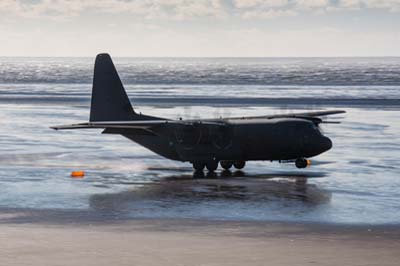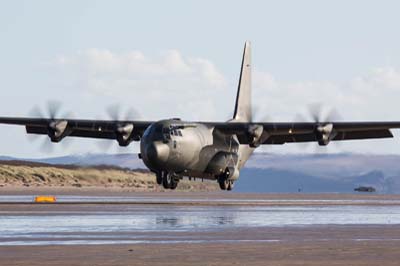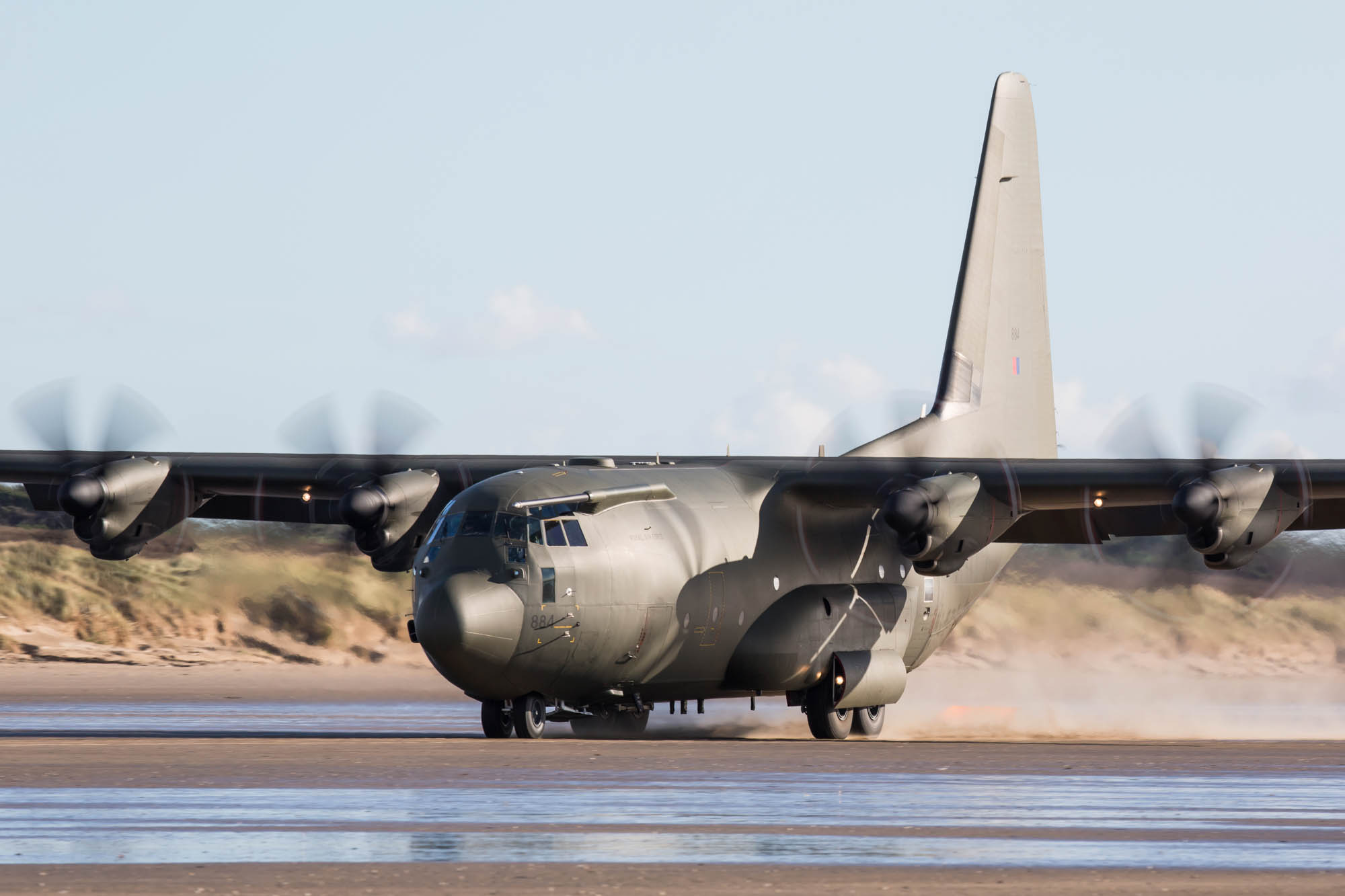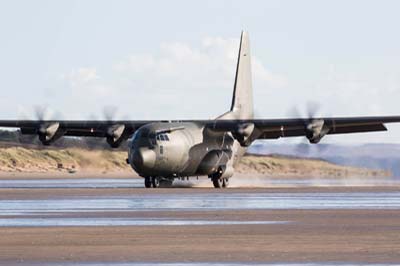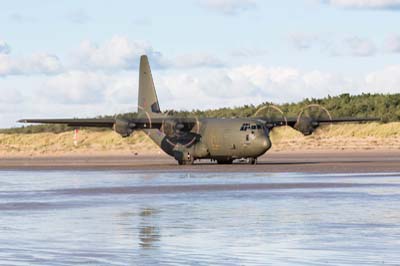Natural Surface Landing Exercise
Pembrey Sands
November 4, 2013
|
Pembrey Sands Air Weapons Range
The weapons range is adjacent to the old RAF Pembrey which was operational from 1937 to 1957. The range is used almost daily by all UK based military aircraft with around 10,000 movements per year.
Pembrey Sands run from a Country Park south of Pembrey town north-west towards the River Towy estuary. The beach is long and when the tide is out very wide it is ideal for Natural Surface Operations (NSO) training for large transport aircraft. Today a Lockheed C-130J Hercules C.5 is scheduled to utilise the beach for landings. To get to the landing area I had walked at least five miles on arrival I found that the ground control team had already marked out the runway with day-glo orange banners. A rectangle of four banners very approximately 100 yards by 60 yards indicating the touchdown point was laid out at both ends of the runway. Support vehicles included; a Rapid Intervention Vehicle (RIV), two Major Foam Vehicles (MFV) and a Pinzagauer RAF Ambulance positioned at the mid-point of the runway. Two Air Traffic Controllers in radio contact with the aircraft were in their own 4X4 vehicle. Following a final inspection of the sand strip and surrounding area the controller was ready to receive the pre-booked C-130J Hercules.
At 11:50 the C-130J (ZH884) made its first approach for a touch and go, this was followed by four more before it landed at 12:30. Rolling out to the far end of the runway it then after a wide turning circle back-tracked the whole length of the runway. After holding for a number of minutes, assumed to be for a crew change, it took off to the north-west to return for another five touch and goes and another landing at 13:05. This time it only ran to just past the mid-point before turning around and back tracking. Again another delay and possible pilot change the take-off was followed by further five touch and goes. The third landing at 13:50, back track and take-off was followed by just another two touch and goes with a final landing at 14:10. This final take-off was followed by a fly past at 14:20 over the sand strip before it returned to Brize Norton at low-level.
Another C-130J (ZH882) 'gate-crashed' the NSO exercise to make one approach and overshoot, it had previously been flying at low-level in Wales including flying through the 'Mach Loop' prior to its arrival at 12:40. This crew had asked if they could make one approach prior to their take-off from Brize Norton.
The photography from the adjacent sand dunes looking towards the sun and later from the seaward side of the runway looking north was approved by the ground controllers after consultation before and during the exercise.
|
 |
| Lockheed C-130J Hercules C.5 (ZH884) of 30 Squadron making an approach to Pembrey Sands with one of the Air Traffic Controllers on hand. |
| Left to right: C-130J Hercules C.5 (ZH884). The first touch and go, its 11:50 and the tide is stil going out. |
| C-130J Hercules C.5 (ZH884) about to touch and go |
| Left to right: C-130J Hercules C.5 (ZH884). The first landing at 12:30, it rolled out to the far end of the runway and taxied all the way back before taking off. |
| C-130J Hercules C.5 (ZH884) departing after a touch and go. |
| Left to right: C-130J Hercules C.5 (ZH884). The long back track. |
| C-130J Hercules C.5 (ZH884) landing for the first time, small stones and sand flying everywhere. |
| Left to right: C-130J Hercules C.5 (ZH884). |
| C-130J Hercules C.5 (ZH884) on finals |
| Left to right: C-130J Hercules C.5 (ZH884). |
| C-130J Hercules C.5 (ZH884) during the third landing at 13:50 |
| Left to right: C-130J Hercules C.5 (ZH884). |
| Close-up of C-130J Hercules C.5 (ZH884) during the third landing at 13:50 |
| Left to right: C-130J Hercules C.5 (ZH884). Approach for a touch and go. |
| Left to right: C-130J Hercules C.5 (ZH884). Final landing at 14:10 and back track. |
| Touching down between the day-glo markers. |
| Left to right: C-130J Hercules C.5 (ZH884). The final landing and back track. |
| Back tracking on a wet sandy beach. |
Left to right: The Air Traffic Controller for the day. The three fire engines and support vehicles were parked at the mid point of the runway and departed very promptly before the final flypast at 14:20. The four touchdown day-glo marker sheets were held in place by two stakes which frequently blew over and always after each departure.
Equipment on task: Alvis Unipower RIV (Rapid Intervention Vehicle), two Unipower 6x6 Carmichael MFVs (Major Foam Vehicle) and a Steyr-Puch Pinzagauer RAF Ambulance. |
| The touch down point between the four day-glo markers showing the tyre marks at the end of the day |



